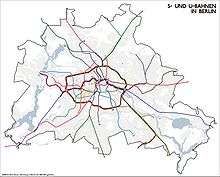U4 (Berlin U-Bahn)
| U4 | |||||||||||||||||||||||||||||||
|---|---|---|---|---|---|---|---|---|---|---|---|---|---|---|---|---|---|---|---|---|---|---|---|---|---|---|---|---|---|---|---|
|
| |||||||||||||||||||||||||||||||
 | |||||||||||||||||||||||||||||||
| Overview | |||||||||||||||||||||||||||||||
| Type | Rapid transit | ||||||||||||||||||||||||||||||
| System | Berlin U-Bahn | ||||||||||||||||||||||||||||||
| Locale | Berlin | ||||||||||||||||||||||||||||||
| Stations | 5 | ||||||||||||||||||||||||||||||
| Operation | |||||||||||||||||||||||||||||||
| Opened | 1 December 1910 | ||||||||||||||||||||||||||||||
| Operator(s) | Berliner Verkehrsbetriebe | ||||||||||||||||||||||||||||||
| Events | |||||||||||||||||||||||||||||||
| 12 December 2004 | U4 designation | ||||||||||||||||||||||||||||||
| Technical | |||||||||||||||||||||||||||||||
| Line length | 2.86 km (1.78 mi) | ||||||||||||||||||||||||||||||
| Number of tracks |
| ||||||||||||||||||||||||||||||
| Electrification | 750 V DC third rail | ||||||||||||||||||||||||||||||
| |||||||||||||||||||||||||||||||
The U4 is a line of the Berlin U-Bahn in Germany, and the second-shortest after the U55 with a length of 2.86 kilometres (1.78 mi). It serves five stations, with only the two termini being step-free.
History
In 1903, the then-independent town of Schöneberg, south-west of Berlin, planned to develop an underground railway line to improve public transportation. As the line promised less profit, the negotiations with the former Berliner Hochbahngesellschaft (English: Berlin Elevated Railway Company) were unsuccessful. Consequently, Schöneberg started to build the line itself on 8 December 1908. Two years later, the construction was finished and, on 1 December 1910, the line was put into operation, as Line BI. Because this line was separate from the pre-existing underground railway, new equipment was required; Schöneberg chose to use tracks and trains compatible with the rest of the fledgeling network, allowing future connections.
Although Schöneberg owned the track, upon opening, it handed operations over to the Hochbahngesellschaft.
The service depot, located after Innsbrucker Platz station, was expanded in 1926 upon the opening of the U-Bahn platforms of Nollendorfplatz station and was closed in 1932. After World War II a high school was built at the site of the former U4 depot. Nowadays, trains use a spur track that connects line U4 to line U1 where they can access the Warschauer Straße Depot on the latter line.
From 1985 until 1993 automatic train operation using the SelTrac system was trialled on line U4. The SelTrac system used on line U4 was manufactured by Standard Elektrik Lorenz (now part of Alcatel-Lucent), and allowed very tight headways of 50 to 90 seconds.
| Wikimedia Commons has media related to U4 (Berlin U-Bahn). |
